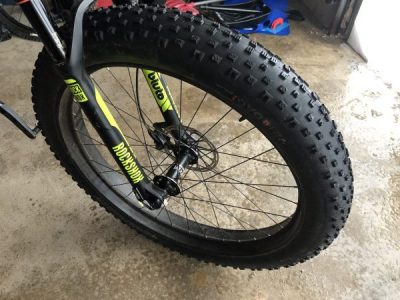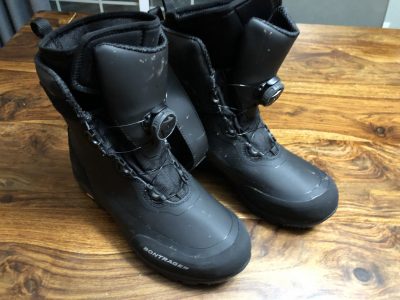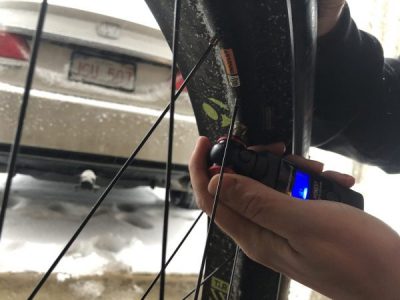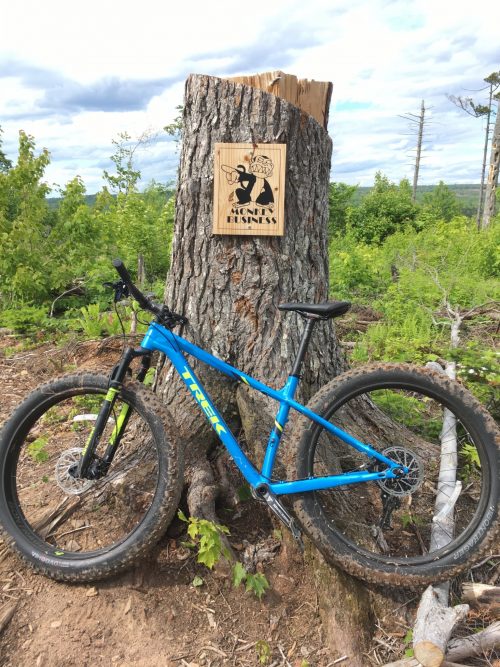Spotting a fat bike out in the wild is hard to miss. These bikes are a head-turner, especially when I ride my fatty on a paved sidewalk during the summer months. Some people are instantly intrigued by this type of bike and want to get started right away on riding them.
The good news is that learning how to ride a fat bike and getting into this type of riding is not that challenging at all. It is very beginner-friendly, as there are trails designed specifically for people who are just starting out.
It makes no sense for a new rider to try incredibly challenging trails, but learning the basics is pretty simple. In time, building up to bigger challenges is all part of the fun.
Finding a Fat Bike that Works and How to Ride It!
The first step to learn how to ride a fat bike is to find one that is the right size and fit. Sizing for a fat bike works the same way as any other type of bike, as there are measurements that people can take based on height, inseam, and more. This makes it very easy to order online, but it is always recommended to try going to a local bike shop at least once to see these fat bikes in person.
Most beginners are going to look for an entry-level model that won’t have all the bells and whistles that some of the other options have. There is no reason to go with something too complicated because most beginners are not going to notice too much of a difference.
As far as making a fat bike a little more customized, there are some factors to consider when doing that initial shopping. Take a look at these factors before putting money down.
Suspension

Some people want a very smooth ride with as little shock as possible on fat bike trails. There is bound to be some discomfort out on the trails, but smoothing things out all comes down to the suspension, as well as tires.
A fat bike tire with no suspension whatsoever is considered rigid. A hardtail option will have a suspension fork in the front, but no suspension in the back. Finally, full suspension is exactly that. Every person is going to have their own preferences, so do not overthink it too much.
Tire Width

Many people who are beginners think that every fat bike has the same width of tires. In fact, there is quite a bit of variation in the fat bike market. Some people will want a tire that is a bit on the low side at around 3.7 inches wide. That is about when mountain bikes turn into fat bikes, so it is right on the fringe of sizing.
Some fat bike tires go beyond 5 inches, which might be a bit too much for a person’s first fat bike. Even though it makes for a very forgiving ride capable of handling any type of condition, it is still frustrating for some people to have to deal with tires that wide.
After making a decision with the tires, there is also the opportunity to switch them out if they just do not work. It will end up costing a little bit more money, but remember that that is always an option.
Proper Clothing and Safety

Once picking a fat bike out is done, the next step is to prepare as far as clothing and general safety are concerned. Many people think that once they order a bike, they don’t need to do anything else. A casual ride can indeed happen with regular clothes, but those people who are planning on taking a longer trip might want to invest in fat bike clothing to help them out a bit.
Every fat bike owner should invest in a good pair of shorts/pants, a jersey, and at least one pair of gloves. Again, this is mostly going to depend on where a person is located.
Those in colder climates will almost always go for longer pants, a jersey that provides some solid coverage and warm, and gloves to do the same. And of course, you can’t forget a good pair of winter boots (My full review on the Bontrager Old Man Winter 2020 Clip-on Boots!) when riding your fatty in the cold of winter.
Remember that if it is cold outside, it is going to be even colder riding on a fat bike. Dress appropriately, and also travel with a change of clothes if it seems like it is necessary. It is always beneficial to be over-prepared instead of underprepared as a beginner.
From a safety perspective, a helmet is the first thing to consider. Investing in a fat bike helmet is going to provide full coverage and protection when on the trail. Even on a beginner trail that seems relatively easy, anything could happen. This is especially true for people who ride in snowy and icy conditions. All it takes is one patch of ice to make a person slip and have a small crash potentially.
Some people will opt to wear additional safety items such as elbow guards, knee guards, and snowshoes. It is always a good idea to be as safe as possible out there on the trails in the beginning. People who or just starting out often overestimate just how much ability they have as a rider. It can be very frustrating for those trying to pull off new moves and putting themselves in a vulnerable position.
The First Ride
The best suggestion for any new rider in the fat bike world is to take their bike out for a casual spin on relatively flat and safe terrain. It is not going to be a delightful experience, but it is a way to feel very familiar with the bike.
Learn how to change gears effortlessly, break properly, lean into turns, and more. Even if a person has experience riding a bike with a different type of set up, fat bikes are a different animal. Most people have an initial feeling that it is safe and comfortable because of the fat tires, but it gets challenging in a hurry on the trails.
Tire Pressure

Something that most new fat bike riders have to get used to is the fact that tire pressure is significantly different than any other type of bike. Instead of filling the tires up with a lot of air, a lot of fat bike tires have extremely low pressure overall. It is common for psi in fat bike tires to be as low as five in some cases.
Every rider is going to be slightly different, so tinker with tire pressure a bit early on. Most people suggest going lower rather than higher in the beginning because it helps with comfort and smoothing out the ride in general.
Just keep in mind that if the first ride is on a flat surface, it might seem like the tires are flat themselves. It is not the case, they just are not appropriately filled for pavement.
Moving to the Trail
After going on the initial ride and testing things out, the next step is to go on a journey for the first time on a trail. There are several trails in just about every corner of the globe. Fat bike riding is taking off, and even if they are not trails built specifically for fat bikes, there are general bike trails available to tackle.
As a new rider, always be very cognizant about the surroundings. No one wants to be that rider who is constantly in the way, taking up a large part of the trail and blocking the way for others. It can be very frustrating to operate that way, and no one wants to be that complicated person who is ruining it for others.
The very first ride on a trail should not be a race in any way. Every person is at least somewhat competitive, but it makes no sense to try to go out there and do as much as possible early on. That is just setting up for disaster, especially if there is a steep hill or wintery conditions outside.
That first ride should all be about having some initial enjoyment but also learning as much as possible about the bike itself.
Even if the terrain is not particularly challenging, try out all the different gears and see how things feel. Brakes should continually go through testing, as it is important to know how quickly they respond if something happens. No one wants to be in the scenario where they are relying on the brakes, but they do not know just how well they respond when squeezed tightly.
Building Up to More and More Challenges
As beginners will learn, fat bike riding is pretty easy to get the hang of early on. Most people can get the gist of operating their bike in just one initial ride. It might seem easy at first, but the average fat bike rider is looking for a bit more of a challenge sooner rather than later.
Much like any type of new activity, gradually build up from that first ride and add new challenges to the mix. It is essential not to try to move too quickly as a beginner because that is how people get themselves in trouble.
No one wants to be the person who goes from beginner fat bike rider to a pretend pro in a matter of days. It takes time to take on the toughest trails, as there is bound to be a lot of unpredictability out there.
If possible, seek out not only other fat bike riders just starting out but seasoned veterans as well. The seasoned veterans will be able to provide feedback on certain trails and let people know if it is challenging or not. They also might give some tips on the local fat bike scene, suggesting paths that fit certain levels.
Other beginners will make a person feel like they are not holding seasoned veterans back when riding in groups. Some people like to ride in fat biking groups, while others will go with a more individual approach. Both types of riding work just fine, but it is always nice to have another person to rely on who is learning along the way as well.
Focusing on the Fun
Everyone wants to go out there and become proficient at riding a fat bike, but there are bound to be some bumps along the way. The most important thing is to continually focus on the fun aspect of riding a fat bike. No one wants to be the person who is treating it like a job or a chore.
There is a reason why the fat bike was purchased in the first place, and that is to explore, get great exercise, tackle a new challenge, and more.
Most people agree after they have a fat bike for a while that it is one of the most enjoyable experiences out there. The bikes might look a little weird out in the wild, but buying a fat bike is a bit like joining a new fraternity.
All of a sudden, it is an instant talking point with other fat bike riders out on the trail. Everyone is usually amicable, and willing to provide help for those who are just starting now.
If for whatever reason the fat bike is not providing a lot of entertainment, do whatever it takes to stick with it for a bit. Some are faster learners than others, and no one should feel discouraged because they do not become proficient at fat bike riding right away.
If it still doesn’t seem to come together, there is always the opportunity to find something else to tackle. No one wants to give up on fat bike riding, but the good news is that the secondary market is very popular in most places. People should have no problem selling their fat bike if it just doesn’t work out for them.
The vast majority of beginners won’t have to deal with the selling process, unless they end up upgrading down the road. Once a beginner settles into riding their fat bike and taking more chances, it becomes one of the most enjoyable experiences imaginable.

